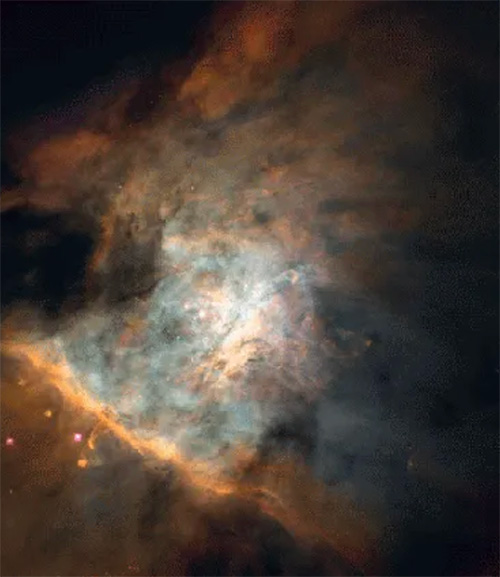The nuclear process of fusion is the source of energy in the sun and other stars. The text and photo below describe a portion of the Orion Nebula as seen by the Hubble space telescope. Critics of nuclear energy and the use of radioactivity often suggest alternatives such as wind or solar power on the basis of those being more “natural” energy sources. The photo below shows the power of nuclear energy as a natural process on a scale that dwarfs anything that man will ever do.

The seemingly infinite tapestry of rich detail revealed by Hubble shows a churning turbulent star factory set within a maelstrom of flowing, luminescent gas. Though this 2.5 light-years wide view is still a small portion of the entire nebula, it includes almost all of the light from the bright glowing clouds of gas and a star cluster associated with the nebula. Hubble reveals details as small as 4.1 billion miles across (less than the distance of Neptune from the Sun). Hubble Space Telescope observing time was devoted to making this panorama because the nebula is a vast laboratory for studying the processes which gave birth to our own Sun and solar system 4.5 billion years ago. Many of the nebula’s details can’t be captured in a single picture – any more than one snapshot of the Grand Canyon yields clues to its formation and history. Like the Grand Canyon, the Orion nebula has a dramatic surface topography — of glowing gasses instead of rock — with peaks, valleys and walls. They are illuminated and heated by a torrent of energetic ultraviolet light from its four hottest and most massive stars, called the Trapezium, which lie near the center of the image. In addition to the Trapezium, this stellar cavern contains 700 hundred other young stars at various stages of formation. High-speed jets of hot gas spewed by some of the infant stars send supersonic shock waves tearing into the nebula at 100,000 miles per hour. These shock waves appear as thin curved loops, sometimes with bright knots on their end (the brightest examples are near the bright star at the lower left).
Credit: Mark McCaughrean (Max-Planck-Institute for Astronomy), C. Robert O’Dell (Rice University), and NASA